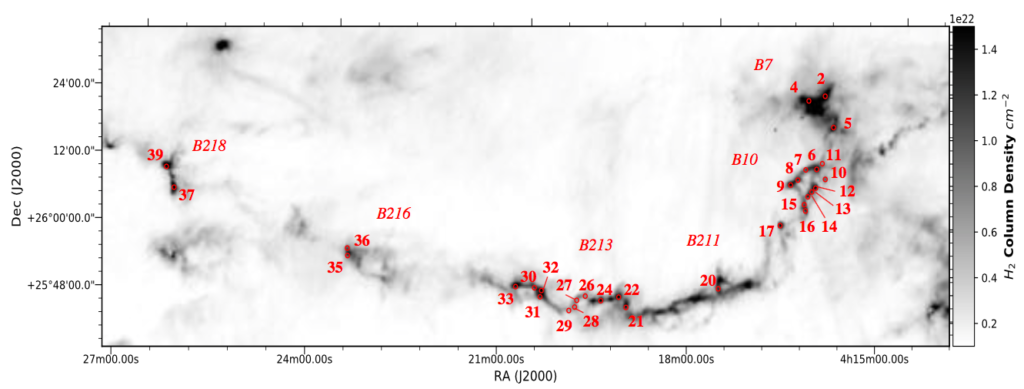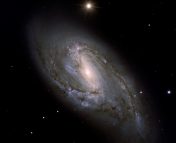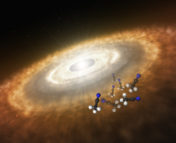Authors: Samantha Scibelli & Yancy Shirley
First Author’s Institution: Steward Observatory, University of Arizona, Tucson, AZ, USA
Status: Published in The Astrophysical Journal [open access on arXiv]
Complex Organic Molecules during the Earliest Stages of Star Formation
Astronomers have long known about the presence of complex organic molecules (COMs) in space and with the advent of more sensitive radio telescopes, discoveries of new and ever more complex molecules continue at a rapid pace. Although crucial for constraining prebiotic chemistry and questions about origins of life, an understanding of the production and distribution of COMs remains elusive. One of the principal goals of any study of COMs is to constrain where and how these prebiotic molecules form in the interstellar medium, prior to potential delivery onto a planetary surface.
Low-mass stars form inside of dense clumps of gas and dust, which are referred to as starless cores. Once these cores are gravitationally bound, but before undergoing gravitational collapse, they are considered prestellar cores. Both of these evolutionary phases – starless and prestellar cores – are ideal for studying the initial stages of chemistry prior to protostar and planet formation due to their relative simplicity, namely: shallow temperature gradients and the absence of an internal heating source and strong shocks/outflows. Investigating complex chemistry in such sources gives us a window into the earliest evolutionary phases in which COMs are observed in the interstellar medium.
COMs are traditionally thought to form on the icy surfaces of interstellar dust particles, where they remain frozen throughout the prestellar phase. As the protostar turns on, subsequent heating then liberates these frozen molecules from grain surfaces into the gas phase, which then drives a rich, warm gas-phase COM chemistry. While this theory is effective in matching observations of COMs during the protostellar phase, it is unable to explain their presence during the starless/prestellar core phase, as there is no protostar yet formed to provide the necessary heating. Further complicating this picture is that the typical COM abundance of starless and prestellar cores is still unknown, as most observations to date have focused on detailed studies of only a few individual cores. To remedy these outstanding questions, today’s authors undertook a large-sample survey of cores within the Taurus Molecular Cloud to characterize the prevalence of complex chemistry and constrain COM formation mechanisms during the earliest stages of star formation.
Survey of Taurus Cores
Today’s authors used the ARO 12m telescope on Kitt Peak to observe 31 starless and prestellar cores within the L1495-B218 filament in the Taurus star-forming region, which is about 440 light years away from Earth. Source selection was based on previous analysis of an existing ammonia NH3 (1,1) intensity map of the region and excluded all objects with evidence of protostellar activity. Figure 1 shows the locations of the selected cores overlaid on a molecular hydrogen column density map of the region.

The survey was designed to detect spectral line emission from two particular molecules: methanol (CH3OH), one of the simplest and most abundant COMs; and acetaldehyde (CH3CHO), which is thought to be chemically related to methanol. These observations provide an unbiased view of chemical complexity in the starless and prestellar core phases as this large sample of cores spanned a wide range of dynamical and chemical evolutionary stages and was localized within a common region in a single molecular cloud.
COM are Common in Taurus
Both CH3OH and CH3CHO are prevalent throughout the surveyed cores in Taurus, as illustrated in Figure 2. In fact, the authors report a 100% detection rate of CH3OH, and a 70% detection fraction for CH3CHO, which implies that both molecules are easily observable in the gas phase toward starless and prestellar cores. Moreover, both molecules are found to have high gas-phase abundances.

In the right panel of Figure 2, the authors plot the derived abundances versus the virial parameter, which indicates if a core is gravitationally bound. Cores that are less gravitationally bound have had less time to collapse and thus are considered less evolved. Regions known to be less-evolved, such as B10, B211, and B216, due to the absence of nearby protostars have correspondingly lower methanol abundances relative to other more-evolved regions. In detail, the authors believe that this is due to chemical differentiation, in which methanol is depleted in the central regions of the cores, and is instead preferentially found in shells around the dense central regions. As this survey likely probed regions where methanol was depleted within a significant fraction of the telescope beam, this leads to artificially lower CH3OH abundance toward more evolved sources.
Taking into account the typical lifetimes of prestellar cores, the authors argue that COM formation must predate the formation of the initial hydrostatic cores by several hundreds of thousands of years. Ultimately, this suggests that protoplanetary disks, the sites of planet formation, are seeded with COMs that formed during these earliest evolutionary phases.
Chemical Relatedness of CH3OH / CH3CHO in Cores
In cold prestellar environments, the most likely formation route of CH3CHO involves CH3OH as a precusor molecule. In support of this pathway, a weak but positive correlation is found between the column densities of CH3OH versus CH3CHO, as shown in Figure 3. Overall, this trend suggests that methanol is important for the gas-phase production of CH3CHO in starless and prestellar cores. The noticeable scatter that is apparent in Figure 3 likely indicates that other factors (i.e., beam filling fraction) may be influencing the relative abundances of CH3OH and CH3CHO.

Further high-spatial resolution observations are need to confirm the chemical-relatedness of CH3OH/CH3CHO and investigate spatial trends, such as chemical differentiation, in these dense cores. Nonetheless, the results from this large single-dish survey makes clear that COMs, which are important in prebiotic chemistry, are forming early and often in the starless and prestellar core stages and at timescales of at least hundreds of thousands of years prior to the formation of protostars and planets.




